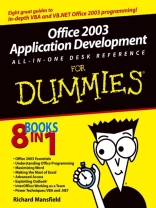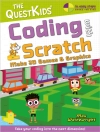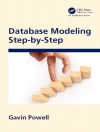* Covers the new features, tools, and technologies in Office 2003
and demonstrates how developers can extend, enhance, and customize
the suite using Visual Basic for Applications (VBA)
* More than 800 pages of clear and friendly For Dummies advice
and instructions help developers get up to speed fast, improve
workflow, and get the job done
* Packed with helpful real-world examples, including creating an
Office document collaboration manager, automating e-mail routing,
administering the Task Pane from within an application, and
building a distributed business system using Web services
* The eight minibooks cover Office 2003 essentials; understanding
Office programming; maximizing Word; making the most of Excel;
advanced Access; exploiting Outlook; Inter Office; working as a
team; and power techniques such as advanced Office automation, VBA,
and .NET
İçerik tablosu
Introduction.
Book I: Office 2003 Essentials.
Chapter 1: Getting with the Program.
Chapter 2: Programming Lite: Making the Most of Macros.
Chapter 3: What’s New in 2003?
Book II: Understanding Office Programming.
Chapter 1: The Basics of Office Development with VBA.
Chapter 2: Managing Data.
Chapter 3: Looping and Branching.
Chapter 4: Managing Files and User Forms.
Chapter 5: Moving to the Internet.
Chapter 6: Debugging.
Book III: Maximizing Word.
Chapter 1: The Word Object Model.
Chapter 2: Power Editing.
Chapter 3: Using XML in Word.
Chapter 4: The Internet Connection.
Chapter 5: Advanced Word Macros.
Book IV: Making the Most of Excel.
Chapter 1: The Excel Object Model.
Chapter 2: Handling Excel Events.
Chapter 3: Advanced Worksheet Editing.
Chapter 4: Data Diving with Pivot Tables.
Chapter 5: Business Analysis with Excel.
Chapter 6: Ten Excellent Excel Macro Techniques.
Book V: Advanced Access.
Chapter 1: Access Today.
Chapter 2: Programming Access.
Chapter 3: Manipulating Datasets.
Chapter 4: Automating Access.
Chapter 5: Troubleshooting in Access.
Chapter 6: Access Macro Techniques.
Book VI: Exploiting Outlook.
Chapter 1: Outlook Power Tools.
Chapter 2: Programming Outlook.
Chapter 3: Managing Work and Life.
Chapter 4: Expert E-Mail Administration.
Chapter 5: Group Management in Outlook.
Chapter 6: Advanced Outlook Macros.
Book VII: Inter Office: Working as a Team.
Chapter 1: Collaboration Features Overview.
Chapter 2: Managing Shared Documents.
Chapter 3: XML and Office.
Chapter 4: Working with Info Path.
Chapter 5: Adding Smart Tags.
Chapter 6: Exploring Smart Documents.
Chapter 7: Using Project 2003.
Chapter 8: Employing Share Point.
Book VIII: Power Techniques: Advanced Office Automation, VBA,
and .NET.
Chapter 1: Advanced Office 2003 Programming.
Chapter 2: Exploring XML.
Chapter 3: Employing Objects.
Chapter 4: Advanced Internet VBA.
Chapter 5: Working with .NET.
Chapter 6: Using Visual Studio Tools for Office 2003.
Chapter 7: Office 2003 Security.
Chapter 8: No More Paranoia: Programmatic Encryption.
Index.
Yazar hakkında
Richard Mansfield’s recent titles include Visual
Basic .NET All-in-One Desk Reference For Dummies, Visual
Basic .NET Weekend Crash Course, Visual Basic .NET Database
Programming For Dummies, Visual Basic 6 Database Programming
For Dummies (all from Wiley), Hacker Attack (Sybex), and
The Wi-Fi Experience: Everyone’s Guide to 802.11b Wireless
Networking (Que).
From 1981 through 1987, he was editor of COMPUTE! magazine,
during which time he wrote hundreds of magazine articles and two
columns. From 1987 to 1991, he was editorial director and partner
in Signal Research and began writing books full-time in 1991. He
has written 34 computer books since 1982. Of those, four became
bestsellers: Machine Language for Beginners (COMPUTE!
Books), The Second Book of Machine Language (COMPUTE!
Books), The Visual Guide to Visual Basic (Ventana), and
The Visual Basic Power Toolkit (Ventana, with Evangelos
Petroutsos). Overall, his books have sold more than 500, 000 copies
worldwide and have been translated into 11 languages.












